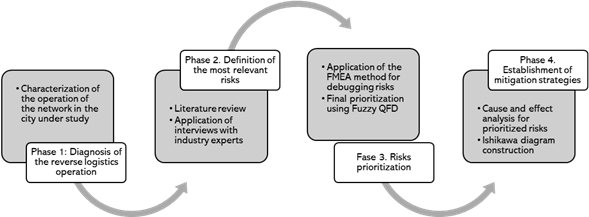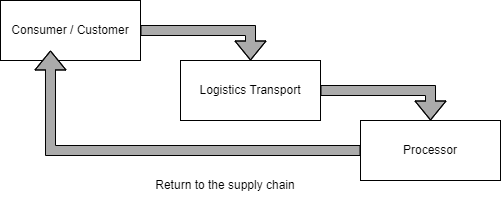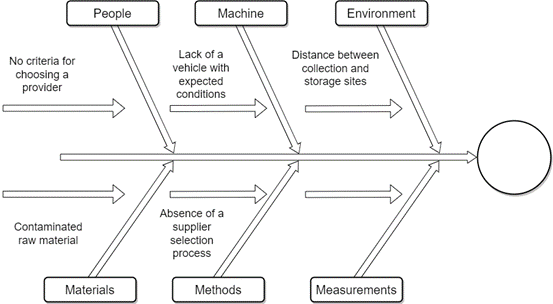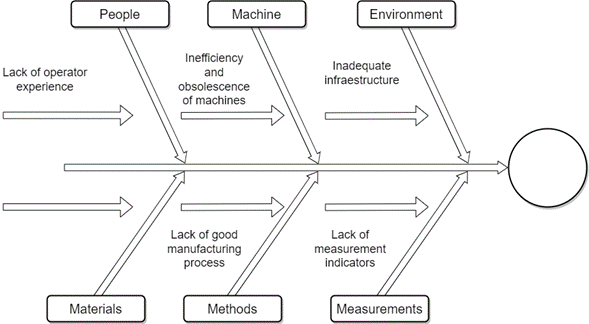I. INTRODUCTION
Companies face different events that can affect their performance and productivity, known as risks. Risk is defined as the probability of a negative economic impact because of the uncertainty associated with the activities carried out [1]. For this reason, organizations must manage all those factors that increase and reduce risks in order to obtain long-term strategic advantages. Risk management in supply chains is essential for researchers and the industry [2] [3]. However, the complexity of this process lies predominantly in the fact that risks, in most cases, cannot be eliminated. Therefore, strategies that seek to identify, prioritize, and mitigate the effects caused by risks should be developed [4].
Supply chain risk management is a complex task since the frequency, severity, and variety of risks are accelerating due to increasing globalization, customer expectations, and shorter product life cycles [5]. [6] establishes that there are two types of risks that supply chains face: disruptive and operational risks. The first one is related to those events generated by natural disasters or man-made disasters. On the contrary, operational risks are associated with the uncertainty inherent in the activities present within the different organizations belonging to the network. Below are some references that have addressed the problem of operational risk management in supply chains.
Big Data was used to establish the risks present in a supply chain of agricultural supermarkets in China, combining a quantitative and qualitative analysis of the risks to generate a risk classification that allows companies to define mitigation strategies for those events more relevant [7]. In the same way, [8] performed a statistical analysis of the risks present in various electronic commerce supply chains to define a reference framework so that organizations in the sector can carry out efficient risk management.
A comprehensive evaluation of the risk factors of a leather supply chain is also highlighted, where, by having a bibliographic search and interviews with experts in the field as a basis, it was possible to identify 44 risk factors associated with the network under study. Then, a Pareto analysis was carried out to discover the most pertinent risk factors (price and cost volatility, inadequate dumping of solids, inadequate treatment of effluents) that must be considered for the successful execution of management practices in a sustainable supply chain [9]. Likewise, [10] defined risk mitigation strategies in a supply chain of perishable products, seeking to improve economic, social, and environmental performance.
Due to the environmental problems that the planet faces today, supply chains have been interested in the reverse flow of products from end customers, which involves processes such as collection, inspection, repair, disassembly, disposal, recycling and remanufacturing from collected products [11]. These operations have been highlighted within supply chains and are known as reverse logistics [12].
One of the industries with the greatest potential for polluting the environment is the manufacturing companies of lubricating oils and greases derived from hydrocarbons, where their production and marketing processes generate a series of largely dangerous residues for both human health and the environment and its ecosystems [13]. The annual volume of lubricant consumption in Colombia is estimated at approximately 18 million gallons per year. Notwithstanding, of the total volume, only 11.7 million gallons per year are known to be collected, equivalent to 65%, to be reused mainly in manufacturing industrial fuels. The destination of the rest of the used oils is not known [14]. Therefore, most oils are discharged into sewers, landfills, water sources or are used in other industries where they are not properly managed [15]. This paper intends to establish the operational risk management for the reverse logistics activity of a supply chain that distributes vehicle oil in a Colombian city with the purpose of reducing the economic, environmental, and social impact that the mismanagement of this operation can generate.
II. METHODOLOGY
As a case study to analyze the operational risks present in the reverse logistics process of used vehicle oil during the first semester of 2021, the city of Guadalajara de Buga, Valle del Cauca, Colombia, was selected. The methodology used for the study is shown in Figure 1, where initially, in phase 1, a diagnosis of the current process in the city under study was made through a characterization of the reverse logistics operation of used vehicle oil. Later, in stage 2, the risks were defined based on the literature review and a series of interviews with four experts in the sector, who work in companies that manage used vehicle oil in the Valle del Cauca region. Next, in phase 3, the prioritization of the risks was established using the failure mode and effects analysis (FMEA) method to make a prior selection of the risks, and then the multi-criteria methodology Fuzzy Quality Function Deployment (Fuzzy QFD) was used. In the last stage, the mitigation strategies for the most relevant risks were established using the Ishikawa diagram.
III. RESULTS
A. Diagnosis of the Reverse Logistics Operation of Used Vehicle Oil
A semi-structured interview was designed to carry out the characterization of the reverse logistics network of used oil in the city under study. The interview also provided information regarding the basic aspects of the network, such as the agents involved, the overview of the collection and treatment process, the main clients, and the uses of the collected material, among others. The interview was conducted with four experts from the sector who work within management companies of this type of waste in Valle del Cauca. With the information collected in the interview and the study carried out by [16], the general configuration of the reverse logistics network was defined, which can be seen in Figure 2.
Consumer / Client: This link represents the person or company where the used vehicle oil collection process is carried out. Among the main clients identified are automobile repair centers, motorcycle repair shops, oil sales points, and gasoline service stations. In the case of the city under study, there are 7 service stations, 65 automotive workshops and 22 points of sale of lubricating oil.
Logistics Transport: The collection is carried out by 18 companies with environmental certifications, which represent 10% of the sample, and by private groups or people seeking economic remuneration, which represent 70%. The remaining 20% is divided into two categories, where the first 10% represents various people in society who buy the residue for agricultural purposes, and the rest are the companies that produce and promote the same oil.
Processor: It is the station defined to carry out some procedures with the collected input, for which an analysis and review of the quality of the collected oil must be carried out to determine the product to be produced. The most common purposes of used vehicle oil are:
Product Reuse: A procedure of filtration, conditioning, and addition of raw materials to the oil is carried out to establish a new cycle of useful life of the product, guaranteeing a notable saving of raw materials in the production of vehicle oil.
Sale: Define potential customers who buy the oil under the established conditions for some other particular use, such as marking land in agricultural areas and use as an energy generator in different industries.
Added Value Products: It consists of using the oil as an input to manufacture other products such as asphalt for road construction, paints, and fertilizers.
B. Definition of the Most Relevant Risks
Different academic databases of Corporación Universitaria Minuto de Dios were explored using keywords such as risk, reverse logistic, risks in reverse logistics, to carry out the identification of the main risks associated with the operation of reverse logistics. Table 1 shows the main results.
Table 1 Definition of risks in the reverse logistics operation of used vehicle oil.
| Risk | Definition | Authors |
|---|---|---|
| Inadequate storage process | The storage process involves different risks, which are drips or leaks, spills, fires, contamination, theft of containers, floods, among others. | [12], [17] |
| Inadequate collection process | A collection process must have an assigned time, good participation of those involved so as not to run the risk of having losses since it also affects the cost of the operation and the quality of the service. | [18] |
| Lack of a suitable vehicle for transportation | The company identifies the risk of not having an adequate vehicle for transportation, which presents a great risk when transporting solid waste since it can affect the environment. | [12], [19] |
| Vehicle routing problem | Due to the environmental problem in the poor disposal of used vehicle oil in Colombia, there is a need to create a scheme with the different waste generating points for the recovery and proper disposal of the waste, considering the distance between each of the nodes and logistics costs, using a vehicle routing problem with capacity constraints, in order to benefit the environment and citizens. | [19] |
| Lack of equipment | The necessary equipment must be available to carry out an adequate collection and treatment of used vehicle oil. | [18] |
| Lack of communication between the parties involved | The planning process ensures that stakeholders understand the reasons for the collection to avoid failures in the process. | [12] |
| Overstock inventory | It can generate excess product in storage, which leads to increased breakdowns and the risk of product loss. | [17] |
| Low quality of the residue | The quality of the waste is of vital importance for the collection company since there must be evidence that the waste is in perfect condition and will not be a problem at the time of its treatment. | [18] |
C. Risk Prioritization Using FMEA and Fuzzy QFD Methods
The FMEA methodology is applied considering the opinion of four experts in the sector on the probability and impact of each of the risks defined in Table 1. It is necessary to take into account that the assessment that the experts were asked to make was given on a Likert scale from 1 to 5, where 1 represented a low probability of occurrence or a small impact of the risk, and 5 referred to a highly probable and adverse effect. Table 2 presents the results obtained, where it is possible to define only 3 risks in a high and medium assessment, which are the ones that obtained a higher PXI rating to 15 (product of multiplying the weighting of impact and probability given by the experts). It must be considered that only these three risks will be taken into account for the application of the fuzzy QFD tool. The prioritized risks are inadequate storage process, lack of a suitable vehicle for transport and low quality of the waste
Table 2 Risks prioritized using the FMEA method.
| Risks | Probability (P) | Impact (I) | PXI | Score |
|---|---|---|---|---|
| Inadequate storage process | 3.30 | 4.3 | 14.2 | High |
| Inadequate collection process | 1.26 | 2.6 | 3.30 | Very Low |
| Lack of a suitable vehicle for transportation | 3.00 | 4.0 | 12.0 | Medium |
| Vehicle routing problem | 1.59 | 3.0 | 4.76 | Low |
| Lack of equipment | 1.82 | 2.7 | 4.93 | Low |
| Lack of communication between the parties involved | 2.00 | 2.2 | 4.58 | Low |
| Overstock inventory | 2.62 | 2.8 | 7.56 | Low |
| Low quality of the residue | 2.88 | 2.8 | 8.32 | Medium |
The fuzzy QFD methodology has been previously applied for evaluating operational risks [4], [20]. The technique consists of the application of 7 phases, which are presented below:
-Phase 1: Identification of the internal variables “Whats”. These variables were obtained through an interview with a team of experts with knowledge of the reverse logistics process of used vehicle oil. Each of them is defined below.
Q1. Establish better communication between the interested parties for the collection of waste in the necessary amounts.
Q2. Stipulate a longer time for the collection of used oil.
Q3. Have the necessary vehicles for the collection of vehicular oil.
Q4. Guarantee adequate storage of the waste at the time of dumping and collection.
Q5. Ensure distribution channels and sale of the collected oil.
- Phase 2: Calculation of the relative importance of the "Whats". Each of the four experts was asked to assess the importance of each internal variable following a diffuse scale proposed in Table 3.
Table 3 Fuzzy linguistic scale used for the assessment of the QFD tool [21].
After having defined the internal variables, we proceeded with the transformation of the linguistic scale using triangular fuzzy numbers and the formula of Equation 1 was applied to obtain the final weight of each internal variable (Table 4).
Table 4 Score of internal variables by experts.
| Experts | Weight (Wi) | ||||||
|---|---|---|---|---|---|---|---|
| 1 | 2 | 3 | 4 | ||||
| Q1 | A | M | A | A | 5 | 6 | 7 |
| Q2 | M | B | A | M | 4 | 5 | 6 |
| Q3 | A | M | M | M | 5 | 6 | 7 |
| Q4 | MA | A | A | A | 7 | 8 | 9 |
| Q5 | M | A | A | A | 5 | 6 | 7 |
- Phase 3: Identification of the strategic objectives of the company. These must coincide with the vision of the organization and are called "Hows". Missions of organizations that are associated with the reverse logistics operation of used vehicle oil were reviewed to find the objectives. The established objectives are defined below
O1. Standardize a more direct communication channel between related entities.
O2. Synthesize a schedule to define a viable collection time according to different parameters.
O3. Design an optimal routing system that allows interweaving the company's schedule and vehicular capacity.
O4. Ensure proper functioning of the activities and resources that are implemented within the general system.
O5. Manage marketing strategies to increase the popularity and demand of the company.
- Phase 4: Establishment of the relationship between the “Whats” and “Hows”. the information is obtained from the evaluators according to their professional opinion, following the linguistic table presented above (Table 3).
- Phase 5: Calculation of the relative importance of the “Hows”. The weighting of the “Hows” is determined based on their relationship with the internal variables “Whats”. Table 5 presents the results obtained after being transformed using Equation 2.
Table 5 Weighting of the strategic objectives "Hows".
- Phase 6: Determine the correlation between risks and the "Hows". For this phase, the most relevant risks are taken, and the correlation they have with the "Hows" is estimated. This rating is obtained through the evaluators, and the relationship matrix between risks and "Hows" is obtained based on this.
- Phase 7: Calculation of the relative proximity of the risks. Finally, the relevance of each risk related to the strategic objectives is evaluated, and with this relationship, an index of relative proximity is obtained using Equation 3. Table 6 highlights the fact that the absence of a suitable vehicle for transport is the most representative risk, followed by the quality of the waste and the inadequate storage process.
D. Establishment of Mitigation Strategies Using the Ishikawa Diagram
Once the risk weighting process has been completed and based on the definition of their priority index, an Ishikawa diagram is created to show the causes that generate the most representative risk in the reverse logistics operation and, from of this, establish a mitigation strategy. Figure 3 shows the diagram created for the risk "Absence of an adequate vehicle for transport", where the main causes are defined: the lack of technology in the current vehicles of the collection companies, which hinders the necessary conditions for the transport and temporary storage of oil. Likewise, there is not a wide range of transport providers that offer the quality of vehicles required for the operation.
Based on these causes, the generation of a comprehensive logistics tool that allows transport providers to be evaluated prior to the operation to determine if the vehicles have all the necessary requirements to carry out the collection of vehicle oil is proposed as a mitigation strategy.
For the operational risk related to the Quality of the Waste, it is found that one of the biggest generators of this is the absence of the appropriate tools for the collection of vehicle oil since, without these, the quality of the oil is very low due to the presence of elements that alter said products, such as water and all types of residues. In addition, another factor is users not having a good experience with the service of extracting oil from vehicles. Thus, they generate large waste or losses during collection, making this system inefficient and incomplete. In some cases, said the risk is promoted by the lack of control measures and follow-ups in the product collection routes by the entities. These causes are summarized in Figure 4. As a mitigation strategy, the design of a complementary improvement plan of 3 sections is proposed, starting with:
Propose a monitoring and control scheme in the collection lines from the client's area to the dumping area, using objective evaluation methodologies through Management Indicators and Improvement Plan Functions.
Standardize staff training processes to improve established procedures.
Implement technical support to the necessary machinery for the collection and carrying out filtration processes to guarantee a quality standard of the product to be collected.
In the case of the Operational Risk related to the inadequate storage process, the deficiency projected when carrying out the procedures and processes for the Storage area of said product is mentioned, determined by a series of 5 causes (see Figure 5 ). The first is that the storage area does not meet the necessary conditions for conserving the material. It may also be that there are no health control measures and compliance indicators that allow the process to be controlled. Finally, the deficiency of the operators at the time of carrying out the activities of dumping vehicle oil in the respective places for reasons of both machinery and experience.
For operational risk 3, the definition of a modification protocol for some areas within the Storage area is proposed as a mitigation strategy:
Structuring of the selected storage area, which manages to collect the appropriate needs to safeguard the quality and conditions of the product in variables of Temperature, Location, and Containers through good storage practices where all the requirements for sustainability must be collected.
Establish quality control methodologies such as 5S to eradicate contamination and govern sustainable quality terms, in addition to parameterizing indicators of compliance and function of the area.
Parameterize process optimization systems through technological tools in the fields of merchandise receipt and dispatch administration, product characterization (Bar Codes) and ABC Inventory Systems.
CONCLUSIONS
The information regarding the operational risks present in reverse logistics activities is scarce since, within the framework of the literature, few authors describe it. Moreover, the variability of the products causes their structuring to vary, and the agents involved in the process are different from each other. In the case of used vehicle oil, there is not much information regarding reverse logistics, which is why this study carried out a characterization of the main links that participate in this operation, thanks to the consultation of secondary information and a series of interviews in places where vehicle oil is sold.
In the literature review of the different databases of the university on the operational risks present in reverse logistics, it is possible to highlight 8 operational risks present in reverse logistics. From this, the AMFE method was carried out, which was approached with the help of professionals in the sector to reach the conclusion that only 3 of them had great relevance to the problem under study. The prioritized risks were: the inadequate storage process, the absence of an adequate vehicle for transportation and the low quality of the waste.
Operational risks must be prevented in the best possible way. Therefore, the fuzzy QFD method was used to evaluate the relevance of the 3 risks mentioned above and identify their priority when defining mitigation strategies. From the analysis carried out, it was concluded that the absence of an adequate vehicle for transport is the highest priority risk.
To carry out the formulation of different mitigation strategies, according to the variety of existing risks that arise for the reverse logistics of used vehicle oil, the cause-and-effect diagram was used, where the main causes of the analyzed risks were represented. A logistics tool that allows the oil transporter to be evaluated beforehand to prevent it from not complying with suitable vehicles for storage and distribution was proposed to mitigate the effect of the most important risk for the operation under study.























